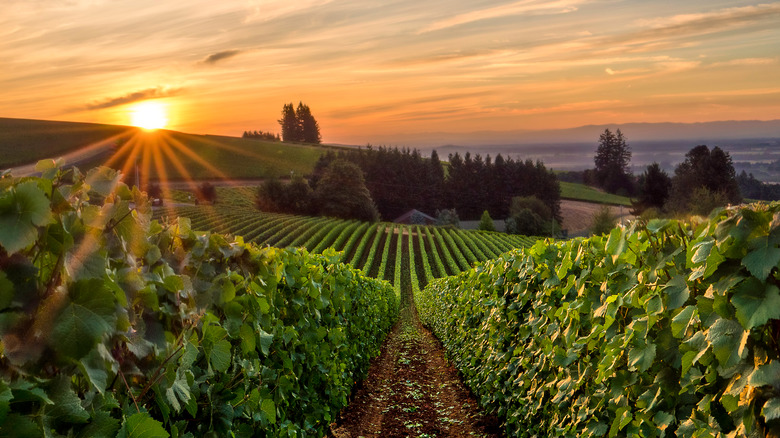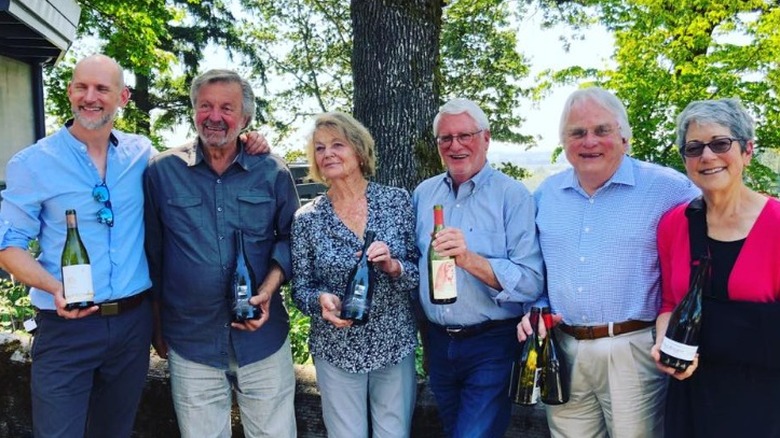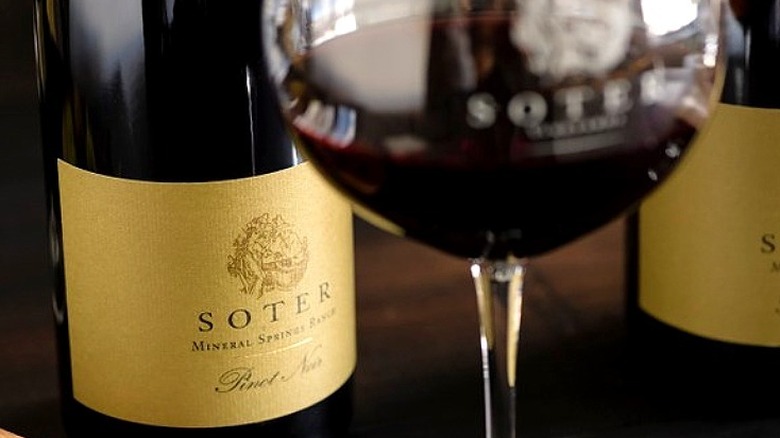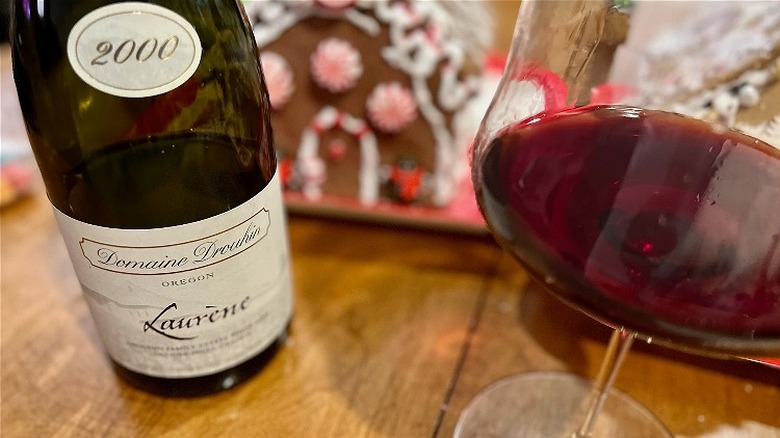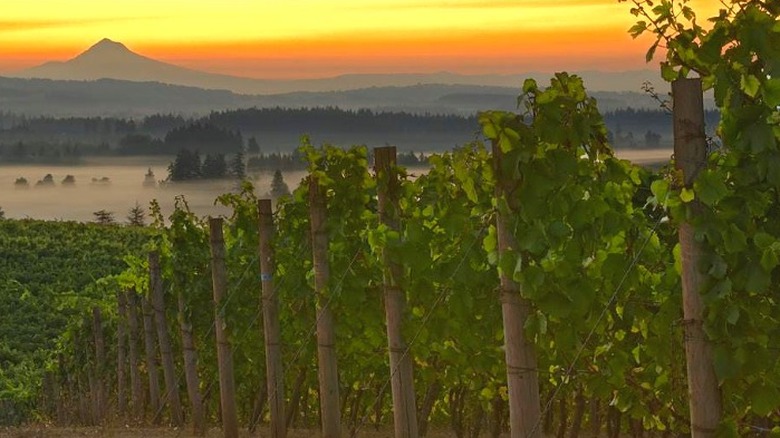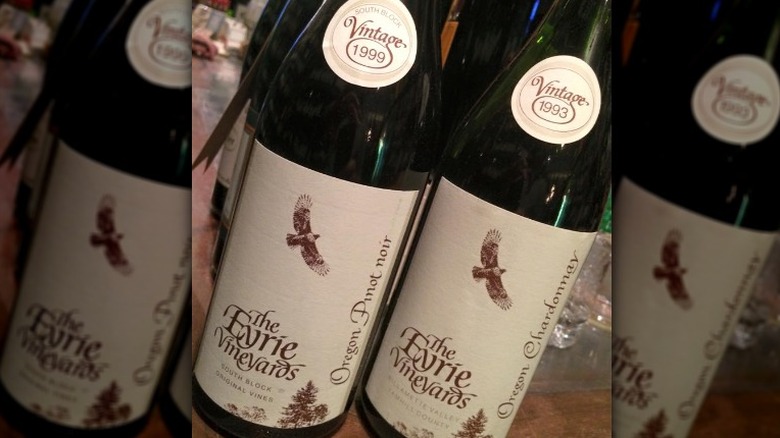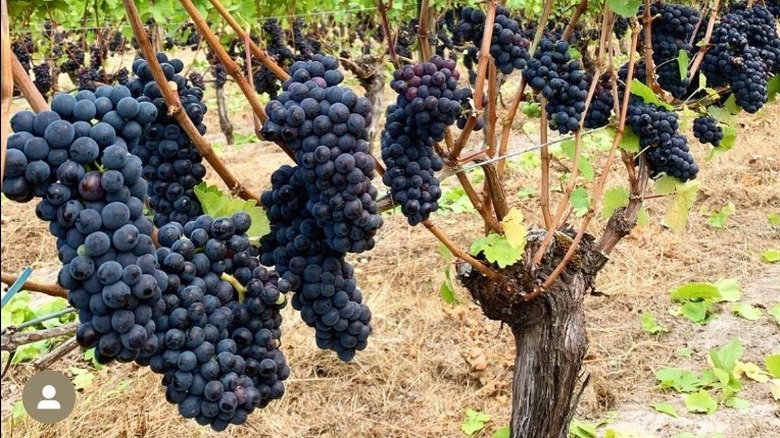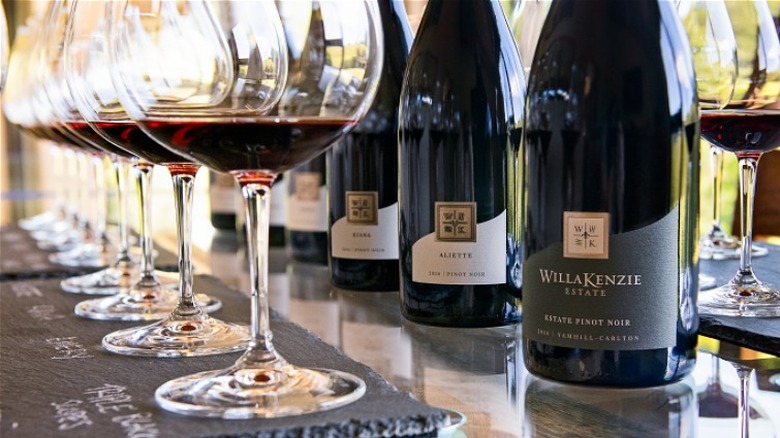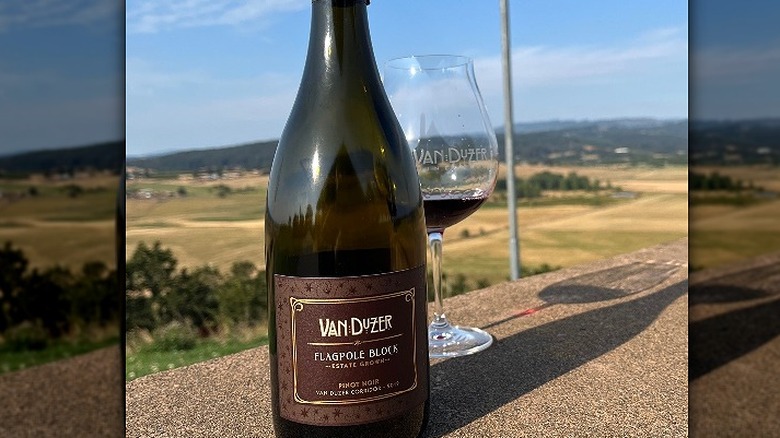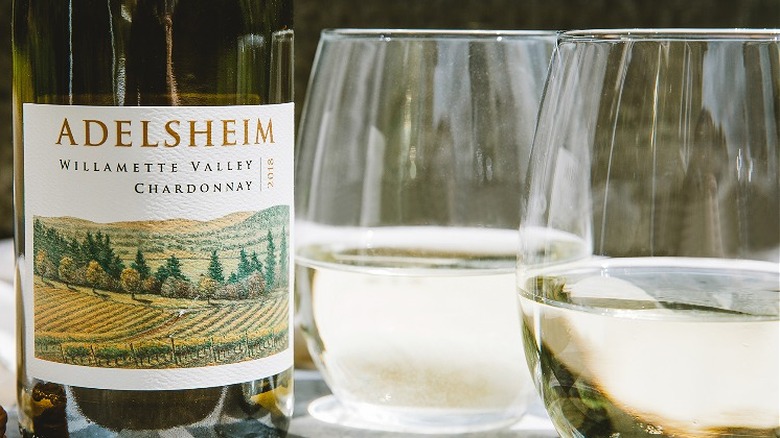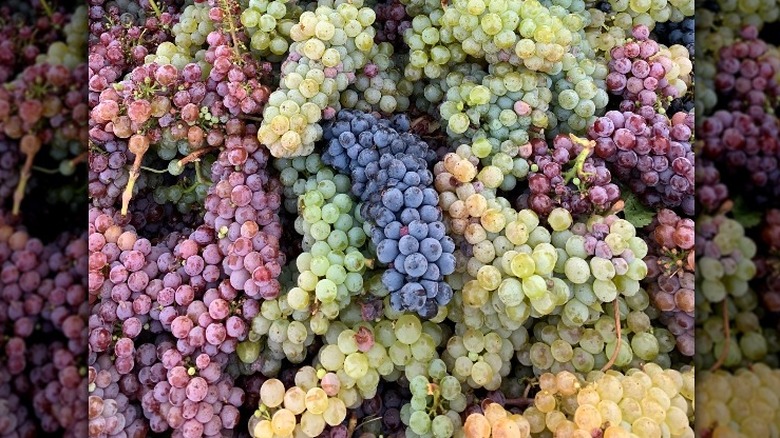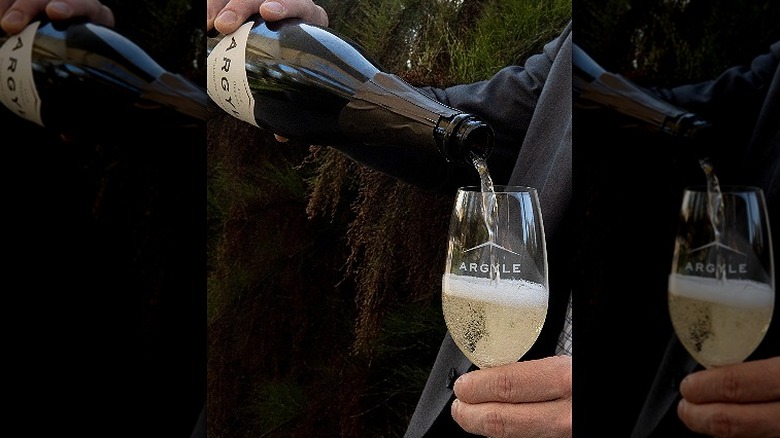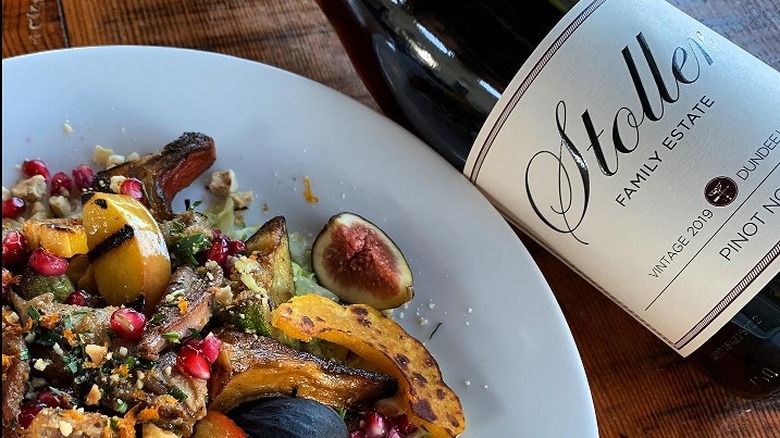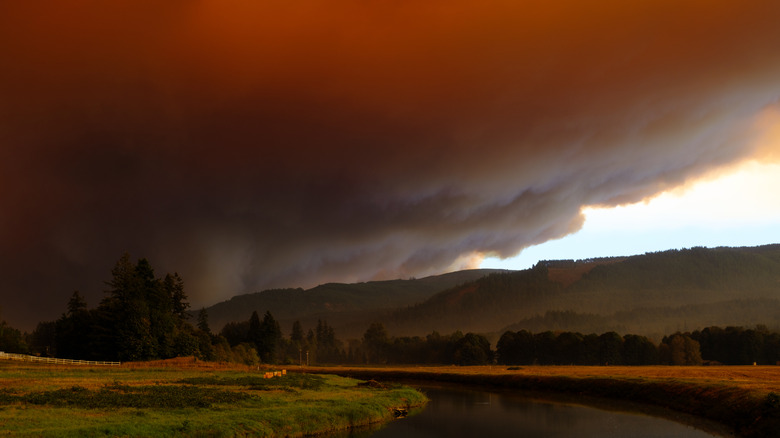The Beginner's Guide To Willamette Valley Wines
Twenty or so years ago, Willamette Valley was commonly referred to by tourists as a quiet wine region that reminded them of how Napa Valley was in the 1960s. It was a laid-back, emerging area filled with adventurers and visionaries determined to create something unheard of in a place no one thought it could happen.
An hour outside Portland, Oregon, near the Pacific Ocean in the cool-climate Pacific Northwest, Willamette Valley is a wine lover's paradise. Willamette Wines shares the Pacific-influenced 60-mile-long region is nestled between the Coastal Range to the west, and the Cascades Mountains to the east, producing the ideal climate for premium pinot noir. Willamette Valley has some of the finest selections of the red variety worldwide, resulting in a recent growth boom.
Oregon Wine Press shares that pioneer David Lett of Eyrie Vineyards recognized similarities between France's premium pinot noir region, Burgundy, and Willamette Valley. In 1965 he was the first to plant vines in Willamette Valley. Pioneers like Adelsheim, Knudsen, and Sokol Blosser have recently celebrated their 50th anniversaries, while new vintners and producers flock to the area.
Today, there are more than 700 wineries dotted throughout the valley. Though each arrives with varying reasons, one commonality carries through. Willamette Valley is the home of excellent wine.
Willamette Valley winemaking is almost 60 years old
Willamette Valley became an American Viticultural Area (AVA) in 1983. The Alcohol and Tobacco Tax and Trade Bureau defines an AVA as an "appellation of origin" or an area with specific geographic and climactic conditions that distinguish it from other surrounding areas. The designation came almost 20 years after the first vines of pinot noir were planted. It was in the late 1960s when the focus on growing grapes in the region began, as pioneering winemakers started planting vineyards in the volcanic and marine sedimentary soils of the Pacific Northwest.
Oregon Wine Press reports the group of visionaries paved the way for the Oregon wine industry. Each arrived believing in Willamette Valley's potential to produce quality pinot noir and a desire to work together to make that happen. The region had a mind for collective success — they figured if one of them did well, they all would. Neighbors were helping neighbors, sharing insight and resources, and creating a wine region unlike any other in America.
We spoke with pioneer David Adelsheim, co-founder of Adelsheim Vineyards. "Much of where the Willamette Valley is today can be attributed to the collaboration between those in the industry over the last 50 years," he said.
Pioneer Dick Erath shares his memories with the Oregon Wine Press, adding he never thought the venture would fail. However, he also never thought it would be such a success.
Willamette Valley pinot noir wines are expensive
Willamette Valley is the hallmark of quality pinot noir in America. And it is expensive. Today, the average price of a Willamette Valley estate pinot noir is around $50.
We asked David Adelsheim about the region's emphasis on pinot noir. "One of the main reasons the Willamette Valley has become a luxury wine region was our focus on a single variety, pinot noir," he said. "Seventy percent of our plantings are pinot noir."
However, growing and producing pinot noir wine is challenging. Wine Spectator reports the variety is thin-skinned, making it prone to sunburn, rot, and mildew, and inherently gives low annual yields. In other words, the grape needs ideal growing conditions to produce a modest crop, making it one of the most expensive varieties in the world to grow.
Tony Soter of Soter Vineyards spoke with Wine Enthusiast in 2020, sharing that bargain pinot noir was historically associated with subpar wine as the variety is so unforgiving. The Yamhill-Carlton vintner's Soter Estate pinot noir has the authenticity and character of Willamette Valley at a $75 price.
Vinepair compares the wines of Oregon to those of California, noting that California wines are more affordable and powerful with fruit-forward flavors. The Oregon options are lighter and more delicate, with restraint and elegance.
Standards are high in Willamette Valley
Another reason for the high cost of pinot noir in Willamette Valley is the state-enforced restrictions on the packaging and labeling of Willamette Valley wines beyond federal regulations. State regulations require that if Willamette Valley is on the label, 95% of the grapes inside the bottle must come from the region, and 100% of the grapes must be grown in Oregon (via Willamette Wines). Additionally, if the label reads pinot noir, that grape variety must make up 90% of the fruit in the bottle. Only 10% can come from other varieties, compared to the federal regulations which allow up to 25%. By restricting the blend, the wine shows authenticity, which is the essence of Oregon pinot noir.
Wine Business reports that thanks to the state's strict standards like this, the region achieved Protected Geographical Indication (PGI) Status approval by the European Union in 2021. The achievement is partly thanks to the focused determination of Harry Peterson-Nedry of RR Wines and Ridgecrest Vineyards. He lobbied for almost a decade on behalf of the region. The recognition affirms the quality of Willamette Valley wine. Only Napa Valley and Willamette Valley carry this distinction in the United States.
New faces continue to arrive, starting with the French
French wine producers are very confident about their wine. JJ Buckley shares that French wine is a source of national pride. For the French to recognize the potential and quality found in the vineyards of Oregon is impressive. The movement began with Burgundy's Joseph Drouhin, which developed Domaine Drouhin in 1987, and most recently, with Bollinger Champagne acquiring the historic Ponzi Vineyards. But the French aren't alone. Portland Monthly reports in the past few decades, large-scale producers like Jackson Family Wines, Ste. Michelle, and the Wagner Family have purchased in the area.
Though the state standards are high and strictly enforced, the region has been historically more affordable than other parts of the world like Burgundy, Napa, and Sonoma (via Decanter and Fermentation). Willamette Valley's premium terroir and affordability continue to draw outsiders to the region from other parts of the world.
These outsiders may come seeking profit versus retaining quality, which has David Adelsheim worried. "First-generation wineries are being sold to wealthy wineries based outside the area. People not (physically based) in Oregon can't be part of that collaboration," he told us. "We need to demonstrate why and how collaboration works continually, and remind everyone that collaboration is a choice. If the majority of influential wineries do not choose to collaborate, then the benefits of collaboration could disappear. Then, the Willamette Valley is just another New World wine region that puts earnings ahead of quality."
Willamette Valley has 11 AVA-designated regions
Willamette Wines reports that as grape varieties go, pinot noir is as site-specific as it gets. The nuances of a piece of land reflect through the fruit and resulting wines. Portland Monthly reports the French call this "terroir" or "taste of place." The publication notes three soil types in Willamette lending to the terroir: Laurelwood, Jory, and Willakenzie.
As the region began its development, a lot depended on chance based on land available for sale. David Adelshiem tells us he decided on Chehalem Mountain because he found a hillside piece of land with Jory soils for purchase — and because David Lett and Dick Erath said it would likely grow grapes.
Looking to improve the process of finding quality vineyard land, Adelsheim and Lett led a group in 1973 to create the Oregon Department of Land Conservation and Development. They mapped the region, designating prime locations suitable for vineyards, and then lobbied to protect the land from other development (via Oregon Wine).
Willamette Wines reports the valley began designating "nested AVAs" within the larger Willamette Valley in 2005. These distinct AVAs have unique characteristics, or terroir, compared to the entire region. Oregon Wine Press reports that each stands independently without being subordinate to any other.
It is similar to how Chianti Classico lies within Chianti which lies within Tuscany, or the region of Pomerol, which lies within Bordeaux. Pomerol's unique terroir allows its distinguishment. Today Willamette Valley is divided into 11 parts, many overlapping one another.
The story starts in the Dundee Hills
Pioneer David Lett selected the volcanic Dundee Hills to plant his vineyard, followed by notable producers like Erath, Ponzi, and Sokol-Blosser (via Oregon Wine). Lett recognized Dundee's unique Jory soil would be the key to producing quality wine, Eyrie Vineyards shares. Now considered the state soil of Oregon, it was deposited within the Dundee Hills 15 to 17 million years ago as volcanic flows. The basalt top layer has decomposed into iron-rich, reddish soils over eroded basalt cobblestones. Portland Monthly reports that the volcanic Jory soils give the wine a unique, iron-rich mineral character and a smoky earthiness.
Vice President of Winemaking for Stoller Family Estates and Willamette Valley native Melissa Burr has been with the estate for over 20 years, experiencing regional growth. As vineyard sites get older and more mature, the wine's concentration becomes more structured and developed, which according to Burr, is exceptional.
We spoke with Burr spoke about the development in the region. "It's humbling to think that even though we produce a small percentage of wine made domestically, ours is known as a distinctive region," she said. Stoller Family Estate is the largest contiguous vineyard in the Dundee Hills. Its estate wines showcase the essence of the land thanks to Burr's hands-off approach allowing the terroir to speak through the wine.
Gold medals came early in Tualatin Hills
Tualatin Hills has some of the oldest vineyards in Willamette Valley, though it just became an AVA in 2020. Oregon Wine shares Charles Coury planted the first vines in the Tualatin Hills in 1965 in Laurelwood soils which today are the grapes for David Hill wines.
But it was Bill Fuller who brought the region early national recognition. In 1973, Fuller planted his Tualatin Estate to pinot noir and chardonnay. In 1984, his flagship red and white won "Best in Show" at the London International Wine Fair. A few years later, Fuller's Tualatin Estate chardonnay was the first Oregon wine to be included in the Wine Spectator "Top 10" list (via Oregon Wine Press).
Zach Morris of Apolloni Vineyards spoke with Tasting Table about the region, the importance of establishing the Tualatin Hills AVA, and the wines of Apolloni Vineyards. He says the designation was a group effort by a handful of regional wineries, including Apolloni and David Hill, as Tualatin has unique characteristics. With higher elevations — nestled in the northwestern corner of Willamette — Tualatin has the region's oldest concentrations of volcanic, windblown silt known as Laurelwood soils. Portland Monthly reports that the soil series produces wines lighter in body than in some areas of Willamette. For Apolloni, its Estate Pinot Noir is juicy and fresh, with a pop of acidity melding with ripe fruits, truffles, and toasted spice.
Yamhill-Carlton is expanding
With 59,000 total area acres and 2600 acres under vine, Yamhill-Carlton is the largest nested-AVA within Willamette Valley, located in the northwestern part of the region. It is home to the region's third primary soil type, Willakenzie. Portland Monthly describes it as dry, almost powder-like soil that produces inky, powerful, black fruit-filled wines.
Yamhill's Willakenzie Estate shows the power of this soil. Tasting Table spoke with winemaker Erik Kramer about his wine. He said the wines of Willakenzie Estate have energy and intensity balanced with an almost weightless, ethereal nature. He says these elements represent "beautiful, classic Willamette Valley pinot noir."
It is an expanding area with owners from outside the region, including French producer Louis Jadot's Resonance Winery, and where America's Jackson Family Wines (JFW) has focused much attention. The company now owns several first-generation wineries, including Penner-Ash, Willakenzie, and the Gran Moraine Vineyard.
Unlike some of the other big players entering Willamette Valley, David Adelsheim tells us JFW is doing it correctly. The company has become an active part of the community, collaborating and putting strong people in the region in leadership roles, namely Willamette Valley veteran winemaker Eugenia Keegan. Keegan joined JFW in 2014 as Senior Vice President of Oregon Winemaking. Wine Enthusiast named Keegan Wine Executive of the Year in 2021.
The Van Duzer Corridor has much gratitude for the Pacific Ocean
Every day blustery winds of the Pacific Ocean blow across the Coastal Mountains Range through the Van Duzer corridor in the southwest part of the region around 2 p.m. local time (via Willamette Wines). These winds keep grapes cool, even in the warmest part of the summer. It also keeps grapes dry and free of fungus. And finally, it gives sturdiness to the grapes, helping thicken delicate skins, and providing structure, power, and complexity to the fruit.
Van Duzer Vineyards utilize this natural corridor to ensure vines enjoy a long, cool growing season. The fruit has a slow, gentle ripening, developing phenolic flavor without losing natural fresh acidity in the grapes.
From the first block of vines on the property, directly in the wind's path, Van Duzer Flagpole Block pinot noir is structured and complex. The flavors reveal ripe red fruits with black tea, dusty leather, and savory mushroom.
Adelsheim Vineyards changed chardonnay in Willamette Valley
The first winery in the diverse, expansive Chehalem Mountain AVA was Adelsheim Vineyards, co-founded in 1971 by David Adelsheim. Like his neighbors, Adelsheim's eye was on pinot noir and cool-climate white varieties like chardonnay.
Robb Report shares that in the early years of planting and discovering, most of the vines planted throughout Willamette came from rootstocks sourced from California clones, a decidedly warmer climate requiring a long growing season. These clones could not achieve flavor, elegance, or phenolic character in Oregon before the harsh autumn rains began.
While visiting Burgundy in 1974, Adelsheim found Dijon clone chardonnay ripening early, before the seasons changed (via Oregon Wine Press). The visionary began importing Dijon clones suited for the Oregon climate. His actions changed the trajectory of the second-most planted vines in the region.
The publication shares that Luisa Ponzi of Ponzi Vineyards believed the introduction of the Dijon clones allowed the essence of the terroir to be reflected through the wine. Using Dijon clones allowed winemakers to express the terroir of Willamette Valley authentically.
We spoke with Winemaker Shane Moore of Gran Moraine Winery regarding chardonnay in the region. He shared his excitement about seeing its growth. "We are all working toward a real identity for Willamette Valley chardonnay," he said. "Great Willamette chardonnay achieves balanced alcohol and acidity, has ample but not over-the-top fruit, and, dare I say, minerality."
Cool-climate white wines thrive in the region
Though pinot noir reigns as the region's red variety, a range of white grapes thrive in the cool climate of the Pacific Northwest. Selections include well-known international varieties like chardonnay, riesling, gewurztraminer, and pinot gris, and the more obscure ones like auxerrios, tocai friulano, and gruner veltliner.
Fifty years ago, Hyland Vineyards in McMinnville planted gewurztraminer. Today, these old vines still produce highly concentrated, nicely structured, aromatic white wines with character. The wine uses only stainless steel in production, revealing clean, fresh, full-bodied flavors of Meyer lemon and tropical papaya with soft herbs of mint and tarragon.
Muller-thurgau, a German variety, can lack excitement and energy, according to Wine Folly. However, when treated accordingly and with quality in mind, it produces vibrant, lively wines with fruit-forward flavors and a bright, balanced palate, as displayed in Sokol Blosser muller-thurgau. The wine shows a mineral-rich core with soft herbal notes, tropical lychee fruit, and fresh citrus.
Sparkling wine production is on the rise
Though sparkling wine has been a part of Willamette Valley's offerings for over 30 years, it has recently become a part of the mainstream conversation. Argyle was the first winery to focus heavily on sparkling wine, established in the Dundee Hills and co-founded by winemaker Rollin Soles.
In an interview with Forbes in 2018, Soles shared that when the winery began, much was still unknown in the region. Producing sparkling wine appealed to him as the American consumer was developing an emerging interest in sparkling wine. And harvesting grapes for sparkling wine occurred earlier than for still wine. An early harvest allowed Argyle to forgo inconsistencies with fruit ripening, a problem some winemakers had as they were learning to make wine in Willamette.
Fast-forward 20 years and the award-winning Argyle wines remain the largest producers of sparkling wine in the region — but they aren't the only ones. Wineries have begun to produce small quantities of sparkling wine to pour in their tasting rooms or for their wine club.
Forbes reports this growth can be thanks in part to the creation of the Radiant Sparkling Wine Company's launch in 2014. The company provides mobile sparkling wine production, allowing wineries without the special equipment or knowledge needed for sparkling wine the opportunity to create a bubbly for their brand. Willamette Wines includes 79 wineries in the association today with a sparkling label.
Pair the wines of Willamette Valley with regional flavors
There is a saying in food when deciding what to pair, "what grows together goes together." In other words, Willamette Valley produces incredible food wines, particularly with flavors of the region.
There are scores of foods in the Pacific Northwest worth trying. It is a forager's playground with hazelnuts, earthy wild truffles, mushrooms, wild berries, and cherries. The Columbia River delivers gorgeous wild salmon, and the Pacific coast provides fresh shellfish like Dungeness crab and oysters.
We like spicy cajun grilled salmon with wild strawberry, watermelon, and citrus-filled dry rose wine from Resonance Vineyards. The sweetness of seared scallops marries the richness of Adelsheim Staking Claim Chardonnay. Argyle Winery's Blanc de Blancs from the historic Knudsen Vineyard balances the salty flavor of Pacific oysters. Stoller Family Estate was built on a former turkey farm, making Stoller Estate pinot noir the perfect complement to Thanksgiving turkey, balancing the weight of a holiday meal.
Willamette Valley welcomes tourists
James Beard put Oregon on the culinary map in the 1960s when he published his book "Delights and Prejudices," sharing his passion for food and the flavors he grew up with in Oregon. The Portland native was a proponent of using local, high-quality ingredients to create dishes with authenticity. This authenticity is carried throughout the Willamette Valley, first and foremost in the wines, as well as in the emerging food and hospitality scene. A welcoming attitude remains intact, even as outsiders arrive and the area grows. The heart of the Pacific Northwest remains.
Melissa Burr shares her excitement about the development in the region, saying, "the tremendous growth in the number of wineries has bolstered tourism, allowing new restaurants and hotels to flourish."
In 2009 the region's first luxury hotel, The Alison Inn and Spa, opened in Newberg. Today it is accompanied by dozens of boutique inns, motels, and bed and breakfasts. Restaurants offer regional cuisine in fine dining to fast casual settings at popular destinations like the Joel Palmer House, Recipe, and Dundee Bistro. And local drivers, like Black Tie Tours, will ferry you from winery to winery or take you on a secret truffle hunt.
Climate Change is a constant concern
Climate change is impacting the wine industry around the world, including Willamette. In 2013, the Oregon Wine Board reported that the effects of climate change, like wildfires and drought, had a $3.5 billion impact on the wine region (via Oregon Live). Wildfires and drought have become a consistent concern for winemakers from California to Canada. The smoke of wildfires sweeping through vineyards producing "smoke taint" can't be washed off in the winery, destroying the fruit's flavor.
During the destructive 2020 fires, some vintners left the fruit on the vines or harvested fruit that they had to dispose of due to the fire damage. A report issued by the Oregon Wine Board states that 62% of Oregon wine growers felt the effects of the 2020 wildfires, with the most impact in Willamette Valley. Of the 844 wineries that reported fire issues, 709 were in Willamette.
Thankfully, mother nature prevailed in 2022. At Stoller, overall tonnage was down, but the winery's vines produced massive grape clusters filled with premium fruit. Melissa Burr says, "this year's harvest has been a wild one," adding it left her "almost feeling miraculous" compared to the past few years.
Vineyard Manager Bruce Sonnen of Van Duzer Vineyards spoke with Tasting Table on the state of this year's harvest, using the word "unbelievable" to describe the 2022 vintage. "The fruit quality we have is outstanding, and I have no doubt it will be a vintage of stellar quality," he said.
